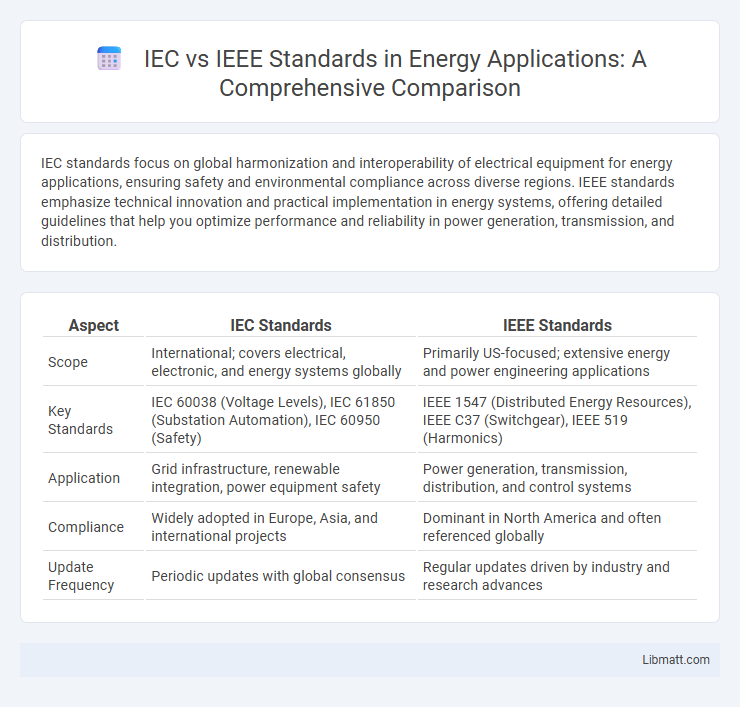IEC standards focus on global harmonization and interoperability of electrical equipment for energy applications, ensuring safety and environmental compliance across diverse regions. IEEE standards emphasize technical innovation and practical implementation in energy systems, offering detailed guidelines that help you optimize performance and reliability in power generation, transmission, and distribution.
Table of Comparison
| Aspect | IEC Standards | IEEE Standards |
|---|---|---|
| Scope | International; covers electrical, electronic, and energy systems globally | Primarily US-focused; extensive energy and power engineering applications |
| Key Standards | IEC 60038 (Voltage Levels), IEC 61850 (Substation Automation), IEC 60950 (Safety) | IEEE 1547 (Distributed Energy Resources), IEEE C37 (Switchgear), IEEE 519 (Harmonics) |
| Application | Grid infrastructure, renewable integration, power equipment safety | Power generation, transmission, distribution, and control systems |
| Compliance | Widely adopted in Europe, Asia, and international projects | Dominant in North America and often referenced globally |
| Update Frequency | Periodic updates with global consensus | Regular updates driven by industry and research advances |
Introduction to IEC and IEEE Standards in Energy
IEC and IEEE standards play a critical role in ensuring safety, reliability, and interoperability in energy applications worldwide. The International Electrotechnical Commission (IEC) develops global standards focusing on electrical technologies, including power generation, transmission, and distribution. IEEE standards primarily emphasize electrical and electronic engineering innovations in energy, facilitating industry advancements and harmonizing technical requirements for your energy projects.
Overview of IEC Standards for Energy Applications
IEC standards for energy applications focus on the safe, efficient, and reliable generation, transmission, and distribution of electrical energy. Key standards include IEC 60034 for rotating electrical machines, IEC 61850 for communication networks and systems in substations, and IEC 61000 for electromagnetic compatibility. These standards ensure interoperability, safety, and environmental sustainability across global power systems and smart grid technologies.
Overview of IEEE Standards for Energy Applications
IEEE Standards for Energy Applications provide comprehensive guidelines ensuring safety, reliability, and efficiency in electrical power systems and components, including generation, transmission, and distribution. Key standards such as IEEE 1547 address interconnection of distributed energy resources, while IEEE C37 series focuses on switchgear and circuit breakers essential for grid protection. Your energy projects benefit from adhering to IEEE standards, as they promote interoperability, performance consistency, and innovation within the industry.
Key Differences Between IEC and IEEE Standards
IEC standards for energy applications emphasize global harmonization, ensuring compatibility and safety across multiple countries with a focus on AC systems, while IEEE standards prioritize innovation and detailed technical requirements primarily tailored to North American markets. IEC standards typically employ a consensus approach involving international stakeholders, whereas IEEE standards often incorporate research-driven practices developed by industry experts and academic institutions. Differences also manifest in the scope of coverage, with IEC focusing on broader system interoperability and environmental considerations, and IEEE emphasizing performance specifications and emerging technologies in power generation and distribution.
Global Adoption: IEC vs IEEE in Energy Sectors
IEC standards are widely adopted across Europe, Asia, and many developing countries, serving as the global benchmark for electrical and energy applications due to their emphasis on harmonization and interoperability. IEEE standards hold significant influence primarily in North America and specific high-tech energy sectors, focusing on innovation and detailed technical specifications. Understanding these regional and sectoral preferences helps ensure your energy projects comply with the most relevant standards, optimizing safety and efficiency worldwide.
Standardization Processes: IEC vs IEEE
The IEC standardization process emphasizes international collaboration among national committees to develop consensus-based standards for energy applications, ensuring global applicability and interoperability. IEEE follows a more industry-driven approach, engaging specialized working groups primarily composed of experts from the electrical engineering community to create standards that address specific technical requirements in energy systems. Both organizations maintain rigorous procedures for public review and revision, but IEC standards often achieve wider global adoption due to their alignment with international regulatory frameworks.
Compatibility and Interoperability Issues
IEC and IEEE standards often face compatibility challenges due to differing regional requirements and technical specifications in energy applications. IEC standards emphasize global harmonization and interconnectivity, while IEEE standards cater predominantly to North American practices, leading to interoperability gaps in equipment and system integration. Addressing these differences requires comprehensive mapping and adaptation frameworks to ensure seamless communication and operation across platforms.
Impact on Renewable Energy Systems
IEC and IEEE standards each play a crucial role in shaping the reliability and interoperability of renewable energy systems, with IEC focusing extensively on global harmonization and safety in photovoltaic, wind, and energy storage technologies. IEEE standards emphasize performance, grid integration, and communication protocols, which are vital for optimizing renewable energy system efficiency and smart grid compatibility. Understanding how these standards complement each other can help you ensure compliance and enhance the scalability of your renewable energy projects.
Compliance and Certification Challenges
IEC and IEEE standards play pivotal roles in energy applications, yet compliance and certification challenges often arise due to differing technical requirements, testing procedures, and regional acceptance. Your energy project must navigate these complexities by aligning with the appropriate standards to ensure interoperability, safety, and regulatory approval across international markets. Achieving certification involves thorough documentation, rigorous testing, and understanding the evolving regulatory landscape tied to both IEC and IEEE guidelines.
Future Trends in IEC and IEEE Energy Standards
Future trends in IEC and IEEE energy standards emphasize increased integration of renewable energy sources and smart grid technologies to enhance efficiency and reliability. Both organizations prioritize cybersecurity measures and interoperability protocols to manage complex energy systems. Advancements in energy storage standards and support for electrification of transportation are also key focuses shaping the regulatory landscape.
IEC vs IEEE Standards (Energy Applications) Infographic

 libmatt.com
libmatt.com